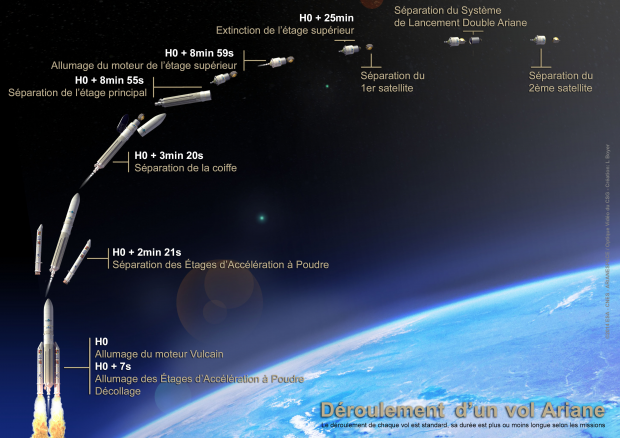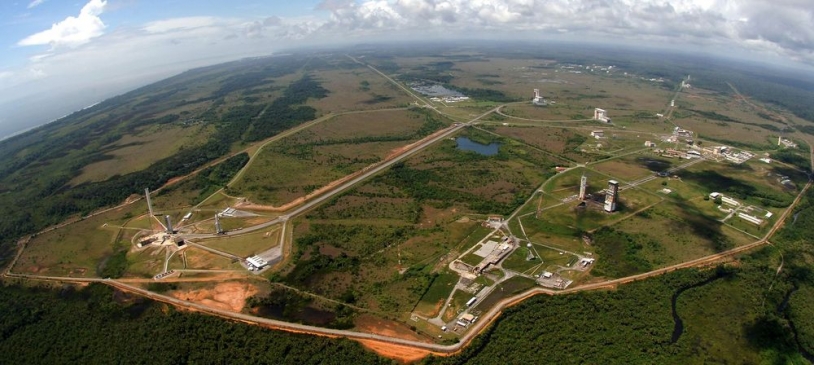Ariane 5

A launcher that adapts to any mission
Ariane 5 is a European launcher designed to put payloads of up to 20 tonnes into orbit. Ariane 5 can target any orbit, whether it is the low, medium, geostationary, or escape orbit.
Since its maiden launch in 1996, Ariane 5 has been available in five versions to carry out all types of missions, from telecommunications and Earth observation satellites to probes exploring the universe. The ECA version is the most widely used, with more than 70 launches, and is used to place two telecommunications satellites in geostationary orbit.
The Ariane 5 programme was approved in 1987 by 12 member states of the European Space Agency.
ARIANE 5 in figures
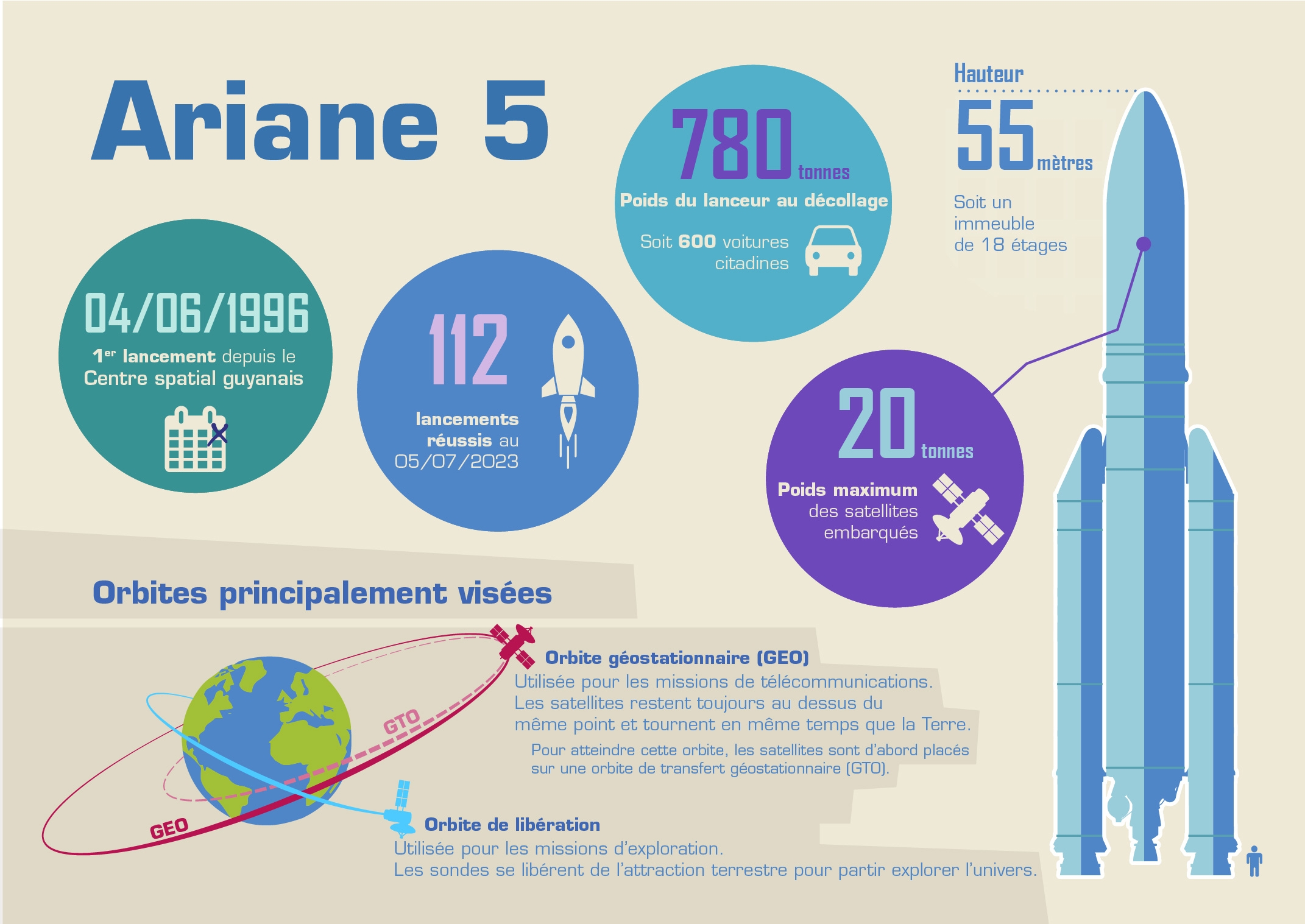
Technical specifications
Ariane 5 is a heavy launcher. It weighs 780 tonnes at lift-off. The launcher consists of a lower section which provides the propulsion, i.e. the thrust of the launcher at lift-off, and an upper section.

The two solid rocket boosters (EAPs) are the launcher’s boosters. They propel the rocket into the sky. Each EAP is equipped with an engine that delivers the thrust of the booster.
The cryogenic main stage (EPC) is the stage that is fired as soon as the launcher lifts off. It provides the propulsion of the launcher after the boosters have burned out and have been jettisoned. The EPC consists of the Vulcain engine and two tanks of liquid oxygen and hydrogen.
The upper stage delivers the thrust of the launcher after the flame-out and jettisoning of the EPC, and allows the satellites to be put into orbit. It varies according to the launcher. For Ariane 5 ECA, the launcher has a cryogenic upper stage (liquid oxygen and hydrogen) and for Ariane 5 ES, a storable propellant stage.
The vehicle equipment bay is the launcher's electronic brain. It houses Ariane 5's monitoring and guidance system.
The fairing protects the satellites from thermal, acoustic and aerodynamic stresses during the first minutes of flight.
More information on the launcher at ariane5.cnes.fr
Launch preparation
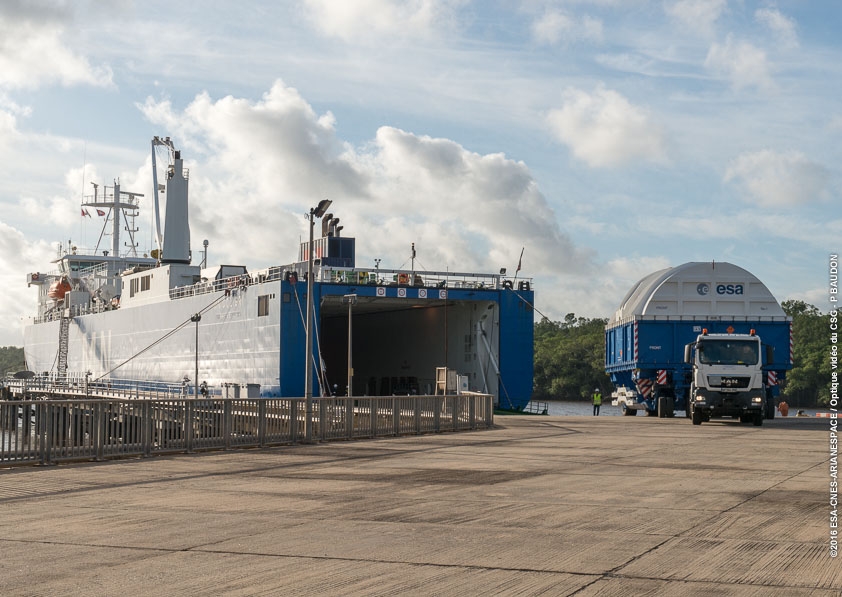
Ariane 5 arrives in french guiana
About 40 days before lift-off, the Ariane 5 components arrive in Kourou by ship. Once unloaded, they are taken to the Guiana Space Centre, to the launcher integration building.
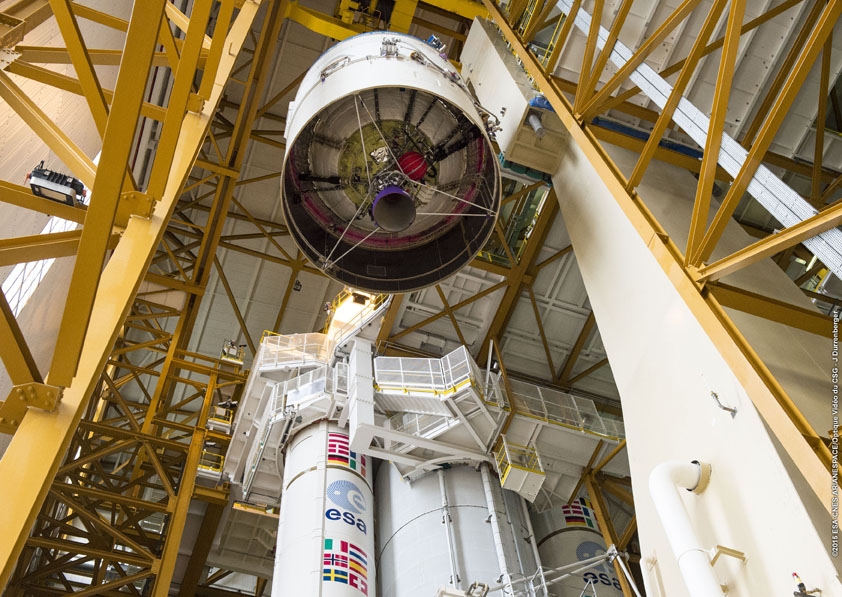
Assembly of the core body
The lower part of Ariane 5 is assembled: the two boosters (manufactured at the GSC), which help it to propel into space, are added to the core body along with the upper stage and the electronic “brain” that controls the launcher.
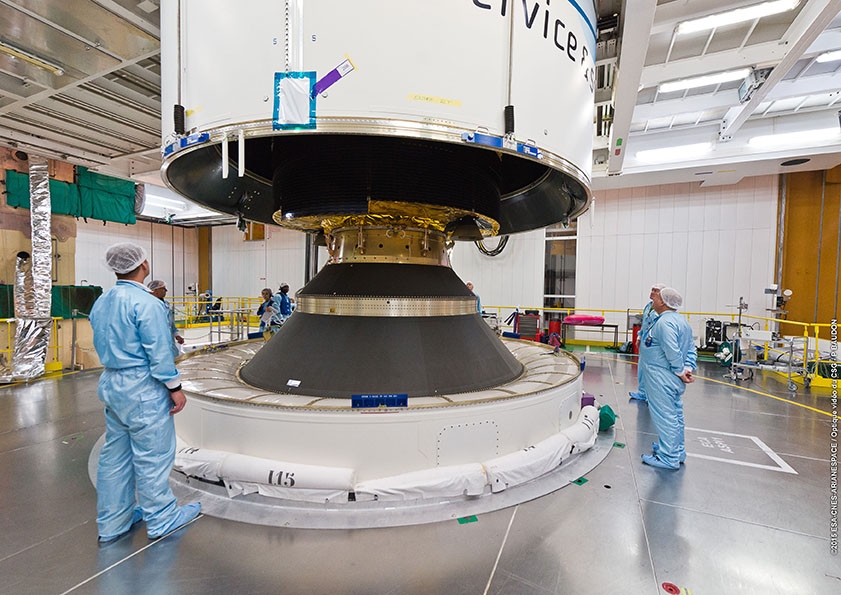
Completion of the launcher assembly
The upper part, consisting of the satellite and the fairing, is integrated on top of the launcher. If two satellites are launched together, they are mounted one on top of the other using an adapter called Sylda, for Système de lancement double Ariane (Ariane dual launch system).
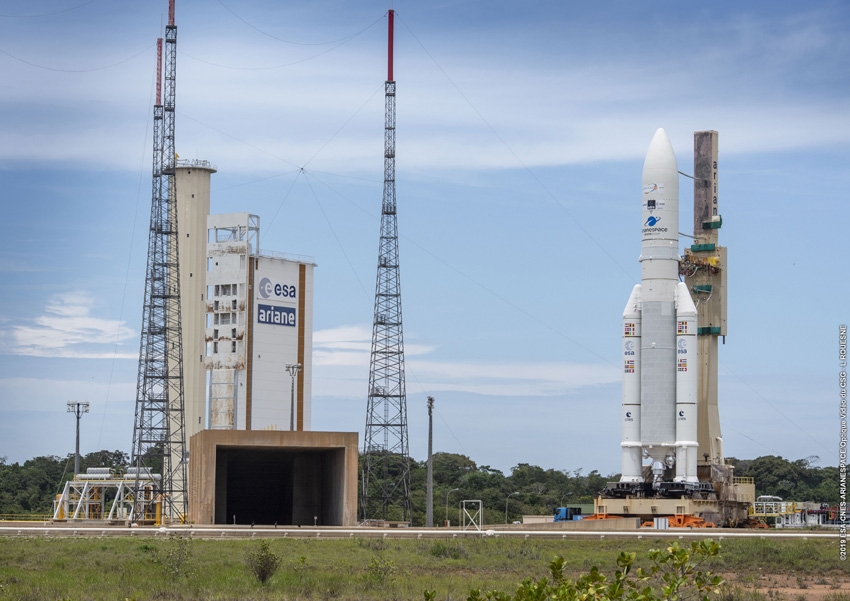
Roll-out to the launch zone
Once fully assembled, Ariane 5 is transferred to the launch zone, towed on rails by a powerful truck. During this trip, it is connected to its transfer unit, which manages the energy, the proper functioning of the system and the environmental conditions required by the launcher and its passengers.

final OPeRATIONS...
Propped against the Cazes tower, which protects it from wind and vibrations, Ariane 5 is filled with fluids and energy. Five hours before lift-off, the cryogenic stage tanks are filled with liquid oxygen and hydrogen and pressurised. These operations are remotely monitored from the Ariane Launch Centre.
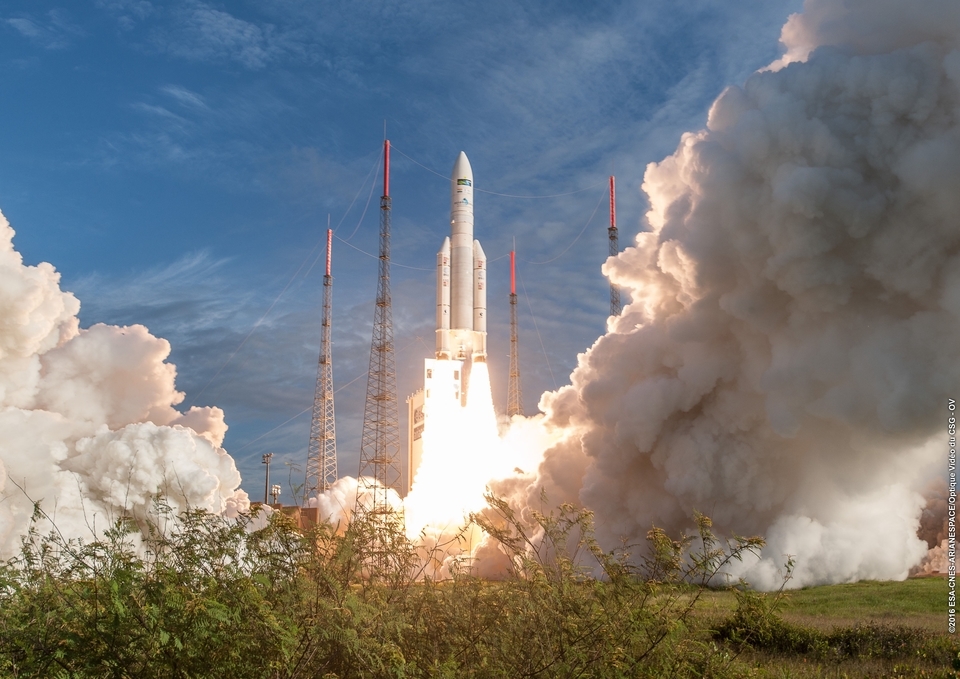
... And lift-off!
In the hours leading up to the launch, the Ariane 5 Launch Centre checks the condition of the launcher, the satellites and the facilities. It transmits the data live to the Jupiter Control Centre. At the scheduled lift-off time, if all these parameters are favourable, if the GSC facilities are ready and if the weather conditions are favourable, Ariane 5 can lift off.
Launch sequence
Engine ignition and lift-off
10, 9, 8, 7, 6, 5, 4, 3, 2, 1, Lift-off! At the scheduled lift-off time, Ariane 5’s Vulcain engine is ignited. But the launcher does not lift off immediately: for seven seconds it carries out tests on the Vulcain engine. If the checks show that the engine is working properly, the two solid rocket boosters ignite in turn. Ariane 5 then lifts off, with these boosters delivering 90 % of the lift-off thrust.
Jettison of launcher components
1,200 t
This is the power delivered by Ariane 5 at lift-off. Which corresponds to twice its weight!
As the flight progresses, the launcher separates from its components that have completed their function, so that only the weight that is useful for the mission is retained.
Each solid rocket booster consumes 2 tonnes of powder per second, and they separate a little over two minutes after lift-off, at an altitude of about 60 km. They fall back into the ocean.
The fairing is jettisoned after three minutes of flight, at an altitude of about 110 kilometres. At this height, there is virtually no atmosphere, so the satellite no longer needs to be protected from thermal, aerodynamic or acoustic hazards. Ariane 5 thus becomes 2 tonnes lighter.
Finally, the booster stage separates at an altitude of approximately 140 km. The upper stage engine then ignites and continues the mission of putting the satellites into orbit.
Satellite separation and end-of-mission
Once placed on the right trajectory and at the right speed, Ariane 5 will release its first satellite. If the launch includes a second satellite, the system for carrying two satellites is ejected a few minutes later. Once positioned at its release point, the second satellite separates from Ariane 5. The satellite operators then take control of the satellites, and can activate their propulsion to put them into their final orbit.
Ariane's upper stage is then deactivated, after being positioned so as to accelerate its re-entry into the atmosphere, during which it will disintegrate.
launch facilities
Ariane 5 has its own launch facilities, located in the Ariane 5 Launch complex. They house the components necessary for preparing Ariane 5 and its launch zone, but also its launch centre, technical buildings and storage areas for the liquid oxygen and hydrogen needed for lift-off.
History
- 1987 : ESA members agree to develop Ariane 5 as a successor to Ariane 4.
- 1991 - 1995 : full-scale tests on Ariane 5 components
- 4 june 1996, V501 : First qualification flight of Ariane 5 G. After 37 seconds, the launcher spins on itself and is neutralised by the safety systems. It would take the project teams almost 16 months to carry out the necessary checks to identify the problem, which was due to a software error.
- 30 october 1997 : Second qualification flight and the first success for Ariane 5, despite a few anomalies: the Teamsat satellite is put into a lower orbit than planned, with no impact on its operation.
- 21 october 1998 : Third successful experimental flight. Ariane 5 is qualified for full operation.
- December 10, 1999, V119: launch of XMM-Newton mission to observe X-rays in space
- 15 november 2000 : record weight put into orbit: over 6 tonnes
- 28 february 2002 : record weight put into orbit: over 8 tonnes
- 28 august2002 : Ariane 5 achieves 10 successful launches
- 11 décember 2002 : First launch of Ariane 5 ECA, a new, more powerful version. The Vulcain engine stops after 3 minutes and 45 seconds of flight due to a nozzle problem. The launcher's preventive self-destruct command is activated.
- 15 february2003 : end of the transition period with Ariane 4, which makes its last flight.
- 27 september 2003 : First launch with three satellites on board Ariane 5
- 2 march 2004 : Maiden launch of the Ariane 5 G+ version, with a more powerful second stage.
- 12 february2005 : First successful launch of Ariane 5 ECA
- 11 august2005 : Maiden launch of Ariane 5 GS, a smaller version with optimised performance
- 9 march 2008 : Maiden launch of Ariane 5 ES, a version capable of putting payloads of over 20 tonnes into low Earth orbit. The launch is a success and Ariane 5 puts the first new ATV space freighter into orbit, to carry supplies to the International Space Station. New record weight put into orbit: 19 tonnes
- 12 june 2008 : 25th consecutive success
- 21 may 2010 : 50th Ariane 5 launch
- 22 april 2011 : record weight put into orbit (not considering the ES version): over 10 tonnes
- 02 august2012 : 50th consecutive success
- 17 november 2016 : Maiden launch of Europe’s Galileo global navigation satellites on board Ariane 5 ES. 75th consecutive success.
- 26 january 2018 : First partial failure of Ariane 5 after 82 consecutive successes, due to a flight plan error. The satellites are put into a lower orbit than planned.
- 25 july 2018 : last launch of Ariane 5 ES. The ECA version becomes the only Ariane on the market until the arrival of Ariane 6.
- 25 september 2018, VA 243 : 100th launch of Ariane 5.
- October 20, 2018, VA 245: launch of the BEPI COLOMBO probe for the exploration of Mercury
- December 25, 2021, VA 256: launch of the James WEBB telescope, the most powerful telescope to date for studying the universe
- April 14, 2023, VA 260: launch of the JUICE mission to study Jupiter
- July 5, 2023, VA 261, 117th and last launch of Ariane 5
Find out more about all Ariane 5 launches
